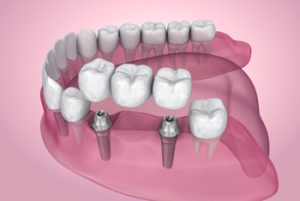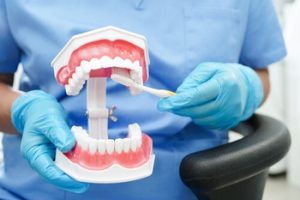Dental bridges can restore function and appearance when teeth are missing, but they require careful maintenance to avoid complications. Among the most serious issues that can arise is infection, which often goes unnoticed until it progresses. Ignoring minor discomfort around a bridge may allow bacteria to affect not just the gums but also the supporting teeth and underlying structures. Recognising early signs is crucial for avoiding long-term damage. Infections around bridges are often underestimated, yet they can compromise the entire dental restoration if left unchecked. That is why understanding symptoms and acting promptly is key to protecting both comfort and overall oral health.
What Are Dental Bridges?
Dental bridges are fixed dental appliances designed to replace missing teeth by anchoring an artificial tooth between two or more existing natural teeth. They rely on abutment teeth for support, with materials such as ceramic or porcelain used to mimic the look and function of real teeth.

Dental implants may also be used in some cases to support a bridge, especially when natural teeth are not suitable. The goal is to restore the ability to chew and speak normally while maintaining balance with the surrounding teeth. Whether you’re replacing missing teeth due to tooth extraction, injury, or decay, bridges serve as a stable and natural-looking solution. However, like all dental procedures, they require proper dental hygiene and routine care to ensure long-term success and avoid future dental bridge problems.
What Happens When a Dental Bridge Gets Infected?
Even a well-fitted bridge is not immune to bacterial activity, especially when oral hygiene practices lapse. Infections may develop silently, progressing under the bridge or along the gumline before symptoms become noticeable. Early detection often requires awareness of subtle changes in comfort or appearance.
Causes Behind Infections
Food particles that lodge beneath or around the bridge can trap bacteria, especially if not cleared properly. Sticky foods or hard-to-reach areas may lead to plaque buildup, eventually triggering inflammation or decay in nearby structures. Over time, these trapped particles create an ideal setting for infection to thrive.
Impact on Gum Tissue
Once bacteria enter the gumline near the bridge area, the surrounding soft tissue may begin to react. Redness, swelling, and bleeding are often the first indicators. If left untreated, the infection may spread deeper, irritating the tissue and resulting in gum infection or even infected tissue beneath the appliance. Periodontal treatment might be necessary to contain the damage.
Weakening of Supporting Teeth
Bridges rely on neighbouring natural teeth for anchorage, which can be compromised by decay or bacterial invasion. Tooth decay below or beside the bridge can jeopardise the abutment teeth and surrounding teeth, weakening the stability of the structure. This may eventually lead to difficulty chewing or bridge loosening.
Complications if Ignored
When early signs are ignored, a dental bridge infection can escalate. Bone surrounding the area may start to deteriorate, increasing the risk of tooth extraction or more intensive dental procedures. Severe pain and deep cleaning requirements can follow if action is delayed.
Hidden Nature of Bridge Infections
Unlike issues with natural teeth, problems around a bridge can be more subtle. The false tooth covers the gum, so the infection may progress quietly underneath. This makes regular dental check ups critical for detecting any early signs of bridge infection before they develop into further complications.
 Signs and Symptoms of a Dental Bridge Infection
Signs and Symptoms of a Dental Bridge Infection
Symptoms of infection under or around a bridge often vary between individuals. While some may notice immediate discomfort, others may not experience clear signs until the condition is more advanced. Knowing what to look for helps catch infections early.
Swelling and Tenderness
The first noticeable signs may include puffiness or gum irritation in the dental bridge area. Gums can become sensitive to pressure or brushing, particularly near the abutment teeth. Persistent swelling that does not subside with rinsing or gentle care may indicate a deeper problem.
Changes in Taste or Smell
An unpleasant taste or noticeable bad breath can signal the presence of infection. Bacteria trapped under the bridge can produce odorous by-products. If rinsing and brushing do not resolve the issue, this sensory change might be tied to an underlying infection.
Unusual Sensations
Tingling, dull aching, or severe pain in the bridge area can occur as infection affects nerves and supporting structures. This discomfort may worsen when eating, especially when biting into hard or sticky foods. If pain increases or persists beyond a few days, it should be addressed without delay.
Visual Clues Around the Bridge
Discolouration of the gums, bleeding while brushing, or a visible gap created between the bridge and gumline are all signals to watch. These could point to gum disease or issues with the dental cement bonding the bridge in place. Any changes in fit or appearance warrant a thorough examination.
Varying Symptoms Based on Health
Each person’s response to infection depends on their general health and oral hygiene habits. Those with diabetes, compromised immunity, or poor oral hygiene may experience more aggressive symptoms. Regular checkups, proper care, and fluoride toothpaste can help reduce risk.
When to Seek Help and What to Expect at the Clinic
Why Delaying Treatment Can Be Risky
Even minor gum irritation or a strange sensation around the bridge area could be the first warning sign. Delaying action may allow bacteria to spread below the surface, putting the entire dental appliance at risk. A small issue that could be resolved with cleaning may escalate into a need for a full replacement. Timely recognition of problems can prevent further complications and protect overall oral health. Acting early supports long-term stability and avoids unnecessary dental issues.
What to Expect During Your Appointment
During your visit, the dentist will begin with a thorough examination of the dental bridge area. They may gently probe the gums and surrounding teeth to identify swelling, discolouration, or areas of concern. Diagnostic tests such as digital imaging or X-rays are often used to assess the underlying infection and structural changes. These tools help reveal problems that may not be visible during a standard visual check. Accuracy in diagnosing the underlying cause is essential for effective treatment.
Treatment Options You Might Be Offered
Treatment will depend on the extent and cause of the infection. Deep cleaning may be used to clear plaque buildup and food particles trapped around the bridge. If needed, you may be prescribed antibiotics to target the bacteria causing the gum infection. In more serious cases, adjustments to the dental bridge or complete replacement may be considered. Temporary dental bridge placement might be required during the recovery period.
 Importance of Follow-Up and Proper Care
Importance of Follow-Up and Proper Care
After the initial treatment, your dentist will advise on proper dental hygiene practices to avoid future infections. They may recommend switching to a soft-bristled brush, using fluoride toothpaste, and avoiding sticky foods that can contribute to plaque buildup. Maintaining regular checkups and professional cleanings ensures the bridge remains functional and infection-free. Following aftercare instructions closely helps preserve the results of your dental bridge treatment. Consistent care also supports overall oral health and comfort.
When to Contact a Dentist Immediately
If you experience symptoms like severe pain, gum irritation, persistent bad breath, or taste changes, reach out without hesitation. These could be signs of an underlying infection that requires immediate attention. Early signs often appear subtle but can eventually lead to more serious dental procedures if left untreated. Always inform your dentist about any change in how your bridge feels or functions. Prompt action leads to simpler, more effective treatment solutions.
Book Your Appointment with Our Experienced Team Today
Infections linked to dental bridges can pose a serious risk if overlooked, especially when symptoms are mild or vague. Knowing what to watch for can help you act quickly and protect both your dental health and comfort. Sensations like lingering soreness, strange taste, or changes in how the bridge feels should never be ignored. With regular checkups and good oral hygiene habits, many of these issues can be caught early or avoided altogether. If you notice any changes or have concerns, our experienced team is here to help. Call us today at (02) 9054 5281 to schedule a visit and receive expert guidance tailored to your needs.
References
https://www.healthdirect.gov.au/dental-bridge
https://www.news-medical.net/health/What-is-a-Dental-Bridge.aspx


 Signs and Symptoms of a Dental Bridge Infection
Signs and Symptoms of a Dental Bridge Infection Importance of Follow-Up and Proper Care
Importance of Follow-Up and Proper Care